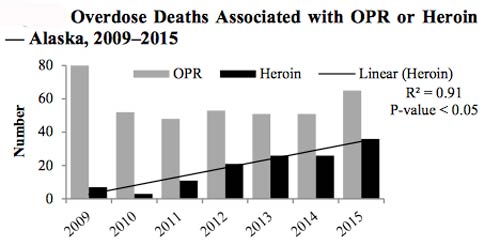
66% of Overdose Deaths in Alaska Prescription Drug Related
March 26, 2016
In 2012, Alaska’s prescription opioid pain reliever (OPR) overdose death rate was more than double the rate in the United States, and Alaska’s heroin-associated overdose death rate was over 50% higher than the national rate.
Chart courtesy Alaska EpidemiologyBulletin No. 6, March 24, 2016 The updated report highlights a number of important points. First, consistent with national trends, heroin overdose deaths have continued to increase steadily every year in Alaska since 2010. Moreover, drug overdose death rates remained highest among males and middle-aged adults, and the regional distribution of drug overdose deaths was considerably higher in regions with urban centers and growing populations, although all Alaska regions were affected. The bulletin edited by Joe McLaughlin, MD, MPH Louisa Castrodale, DVM, MPH, listed the preventive measures that are needed statewide to reverse the drug addiction and overdose death epidemic in Alaska. Included in the list is the adoption of new guidelines for management of chronic pain and increasing the availability of naloxone to reverse potentially fatal respiratory depression cause by opioid overdose. A new life-saving measure just signed into law will make the adoption of new guidelines possible. SB 23 preventing opioid overdose in Alaska, was signed into law on March 14, 2016 by Governor Bill Walker. This law removes civil liabilities from doctors and trained bystanders who prescribe and administer naloxone, a drug intended to counteract the negative effects of an opioid overdose. The bill follows HB 369, known as the “Make the Call” Good Samaritan bill, which was passed in 2014 and offers restriction from prosecution for those who seek medical help when someone they know is experiencing an overdose. Studies have shown that most overdoses are witnessed, and there is a one to three hour window in which an opioid overdose can be reversed, making many deaths preventable. A 2010 report from the Center for Disease Control credited overdose education and naloxone distribution for more than 10,000 documented overdose reversals since 1996. During 2009–2015, the average annual age-adjusted drug overdose death rate was 15.0 per 100,000 persons. During 2009–2014, rates by sex were 17.0 per 100,000 males and 12.9 per 100,000 females. Rates by race were highest among American Indian/Alaska Native (AI/AN) people, followed by Whites, Blacks, and Asian/Pacific Islanders (20.2, 15.3, 11.8, and 4.0 per 100,000 persons, respectively). Death rates by age-group were highest for adults aged 45–54 and 35–44 years (28.6 and 28.5 per 100,000 persons, respectively). Rates by region were highest in Anchorage/Mat-Su (17.5 per 100,000 persons), followed by the Gulf Coast, Interior, Southeast, Southwest, and Northern regions (16.2, 12.6, 11.7, 7.3†, and 6.3† per 100,000 persons, respectively). In 2010, the rate of opioid pain reliever-associated overdose deaths declined considerably from 11.2 per 100,000 persons in 2009 to 7.3 per 100,000 persons in 2010; however, the rates have not changed substantially since then. By comparison, since 2010, the number of heroin-associated overdose deaths increased more than 10-fold from less than 5 deaths in 2010 to 34 deaths in 2015. It was noted that the Substance Abuse and Mental Health Services Administration provides assistance to states to enhance and maximize prescription drug monitoring programs. It also offers a range of services and support to help states and local communities implement prevention programs, improve access to treatment and rehabilitation services, and expand education and law enforcement initiatives. The Alaska Bureau of Vital Statistics mortality database was queried to characterize the epidemiology of deaths due to drug overdose using International Classification of Disease, 10th Revision (ICD-10) Codes for drug poisoning. The analysis included all overdose deaths that occurred in Alaska; it did not include Alaska residents that died out-of-state. Age-adjusted death rates were calculated for 2009–2014 using Alaska Population Estimates (the most recent population data available through 2014) and 2000 U.S. Census data.
On the Web:
Edited by Mary Kauffman, SitNews
Source of News:
Representations of fact and opinions in comments posted below are solely those of the individual posters and do not represent the opinions of Sitnews.
|
||
